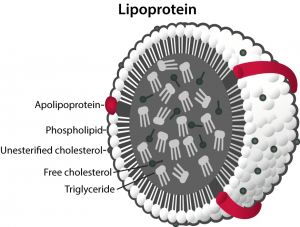Today we are going to talk about Apolipoproteins and their role in uncovering trends towards cardiovascular disease. In order to understand what Apolipoproteins are, we need to go back to the cholesterol molecule itself. Cholesterol is a hydrophobic or “water-repelling” molecule and therefore needs a protein transporter molecule to move in the blood. These proteins are called apoproteins. Once bound to lipids these apoproteins are called apolipoproteins and that is what we are able to measure in the blood. The whole package or “vehicle” that carries the cholesterol (and the apolipoprotein, the phospholipid, and the triglyceride), is called a Lipoprotein.

The apolipoproteins themselves are found on the surface of the lipoprotein and help hold the lipoprotein together. The major lipoproteins are Low-Density Lipoprotein, the familiar LDL and High-Density Lipoprotein commonly known as HDL.
Apolipoproteins come in different shapes and sizes. Two of the most important ones are :
Apolipoprotein A-1 (Apo-A1) and Apolipoprotein-B (Apo-B)
Most Apo-A1 is found on High-Density Lipoproteins – HDL and the majority of Apo-B is found on Low-Density Lipoproteins – LDL
Apolipoprotein A-1 represents 60-70% of the protein content of HDL and plays a crucial role in transporting cholesterol from peripheral tissues to the liver for processing and degradation.Evaluation of Apo A-1 levels can help determine cardiovascular risk in those with reduced levels of HDL, increased cholesterol and triglycerides, and those with a family history of cardiovascular disease.
Elevated levels of Apo-A1 are considered protective against cardiovascular disease and are believed to be a greater predictor for a lower incidence of cardiovascular disease than HDL alone.
Low levels of Apo-A1 are associated with an increased risk of cardiovascular disease.
Apolipoprotein B facilitates the transport of lipids through the bloodstream. Apo-B combines with dietary lipids to form the triglyceride-rich lipoprotein called VLDL
Over time as it travels through the blood, VLDL “drops off” its triglyceride content to become the cholesterol-rich lipoprotein known as LDL.
Apo B levels tend to mirror LDL levels so will be elevated when LDL cholesterol is elevated. Evaluation of Apo-B levels can help assess cardiovascular risk and factors underlying elevated triglycerides.
Elevated Apo-B corresponds to elevated LDL and non-HDL cholesterol with an associated increased risk of cardiovascular disease and an associated increased risk of atherosclerotic coronary artery diseaseSome would suggest that Apo- A1 and Apo-B are much better markers for cardiovascular disease than traditional lipid studies.
For the sake of completion, I want to cover a 3rd lipid marker called Lipoprotein (a) or Lp (a). Lipoprotein (a) or Lp (a) is a small dense lipoprotein composed of a low-density lipoprotein particle and one apolipoprotein B100 molecule linked by a disulfide bond to apolipoprotein(a).
Excess Lp(a) is associated with an increased risk of cardiac death in those with coronary artery disease and stroke and increased blood levels of Lp(a) may be a strong independent risk factor for atherosclerosis and early cardiovascular disease.
All 3 of these biomarkers are now available in the ODX Application so go ahead, measure them in your patients and add them to their Functional Health Report!